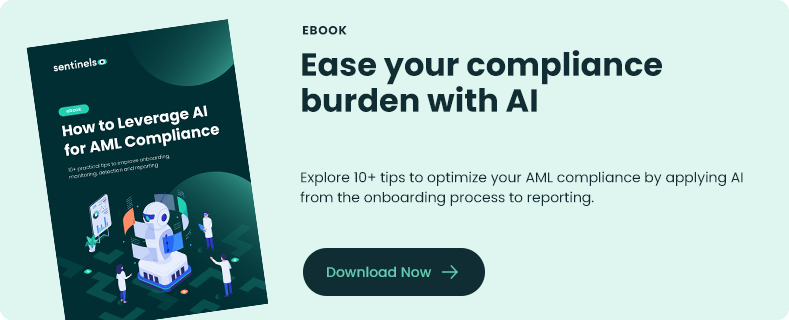AI adoption is currently a burning trend in the regtech industry. But what is regtech? And how do you utilize it in onboarding—the first of the 4 key regtech processes?
5 Ways AI can Boost the Regtech Onboarding Process
AI adoption is currently a burning trend in the regtech industry. But what is regtech? And how do you utilize it in onboarding—the first of the 4 key regtech processes?
Sentinels
Regulatory technology (‘regtech’) is an industry that’s projected to grow by 23% and 25% year-on-year between 2018 and 2023, resulting in a global market size of US$33.1 billion by 2026.
A good proportion of this growth can be contributed to the trend that is the adoption of artificial intelligence (AI) in the regtech space. Powerful AI solutions are helping firms in heavily regulated markets such as finance, to achieve compliance more cheaply, efficiently, robustly, and, in many cases, automatically.
In this four-part blog series, we’re going to explore how AI is being utilized in the four key regtech processes—onboarding, monitoring, detection, and reporting—to help regulated firms stay compliant and ahead of the latest regulatory developments.
Before diving into the different processes, however, let’s first define what regtech is and why it’s important.
What is RegTech?
Regtech is an emerging technology that focuses on the management of regulatory processes within the financial services industry.
Regtech as a term was coined by the UK’s Financial Conduct Authority (FCA) in 2015 who called it: “A subset of fintech that focuses on technologies that may facilitate the delivery of regulatory requirements more efficiently and effectively than existing capabilities.”
Why is RegTech Important?
Simply put, regtech is any technology that helps firms comply with increasingly stringent and punishing regulatory requirements – that’s why it’s so important.
Regtech first started gaining traction following the implementation of MiFID II (The Markets in Financial Instruments Directive) by the European Union in 2018.
Since then, further legislative efforts such as the 6th Anti-Money Laundering Directive (6AMLD) have piled more and more pressure onto firms in terms of compliance, making it much more difficult to rely on manual and older legacy processes to stay in compliance.
What is Onboarding in Regulatory Compliance?
Onboarding is arguably the most important of all regtech processes. The onboarding process is when new clients are screened and checked according to anti-money laundering (AML), Know Your Customer (KYC), anti-terror financing, and other regulations.
Financial firms must carry out these thorough checks to ensure that their clients and their funds are legitimate.
While onboarding has historically been a manual process carried out by compliance experts, digitalization has completely flipped it on its head. In today’s competitive digital environment, having a simple, seamless tech-led client onboarding process is no longer an option: Firms must adopt an agile tech-led to not only please their clients and move with the times but also ensure complete compliance with rapidly changing regulations.
Today’s leading fintechs have merged AI with their onboarding processes by making it completely digital. Whether through in-house systems or third-party regtech platforms like Sentinels, these firms recognize that this is essential in an industry where over 70% of consumers end their relationship with a company because of poor customer experience.
How is AI Used in the RegTech Onboarding Process?
AI can be utilized in the onboarding process in many ways, for example:
- Document authentication: Clients often must submit documents such as passports and driving licenses to authenticate their identity as part of basic KYC checks. AI can be used to check images of identity documents and ‘passport selfies’ to check things like whether the documents are authentic and whether they match the client.
- Eliminate duplication: The onboarding involves a lot of information and data, and it’s possible for this to be duplicated across different internal systems. AI can be used to detect and reconcile duplicated data automatically, keeping your systems tidy and your firm compliance with data protection regulations.
- Detect suspicious clients: AI can be used to monitor watchlists, sanctions, and other information to identify any potential problem clients from the outset. This saves firms time and potentially safeguards them against doing business with clients that could cause compliance issues.
- Collect more data: AI makes it possible to identify more data that’s available to be collected from a wider range of external sources in places where a human operator might never have looked. This helps firms build better risk profiles and make more informed decisions about working with potential clients.
- Build a deeper understanding: AI provides firms with a more comprehensive view of a new client’s business activities from the outset. This makes it easier for firms to avoid working with potential problem clients, particularly where problematic activities are nuanced.
The onboarding process is one where it’s easy to let standards slip, yet it’s the most important of them all. With criminals employing more sophisticated fraudulent tactics to get around manual onboarding checks, it’s also a process where you need AI to have your back.
In the next part of this blog series, we’re going to look at the role AI is playing in the regtech monitoring process.



